Unit10 第四课时((无答案)-九年级英语下册教案
- 格式:docx
- 大小:58.94 KB
- 文档页数:13
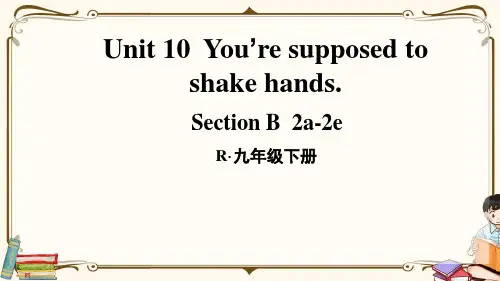
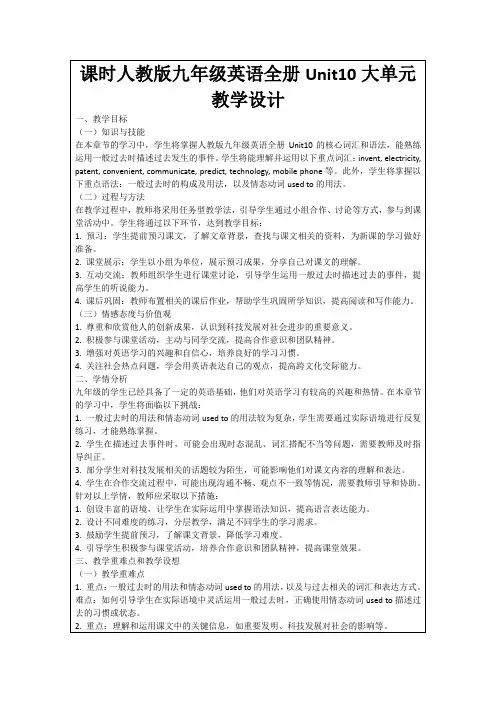
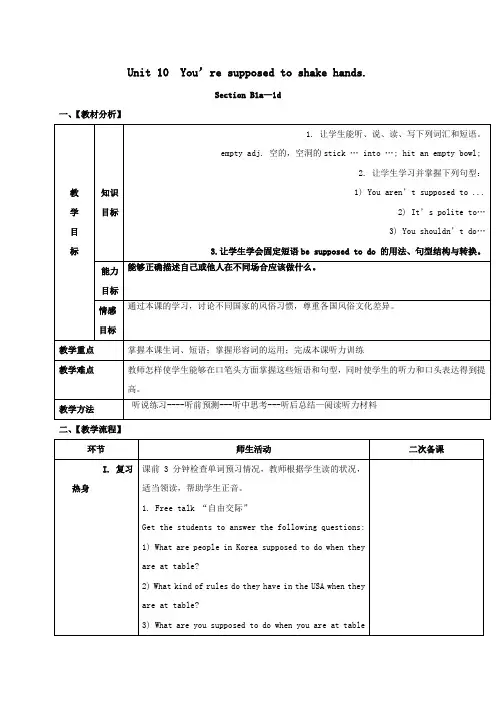
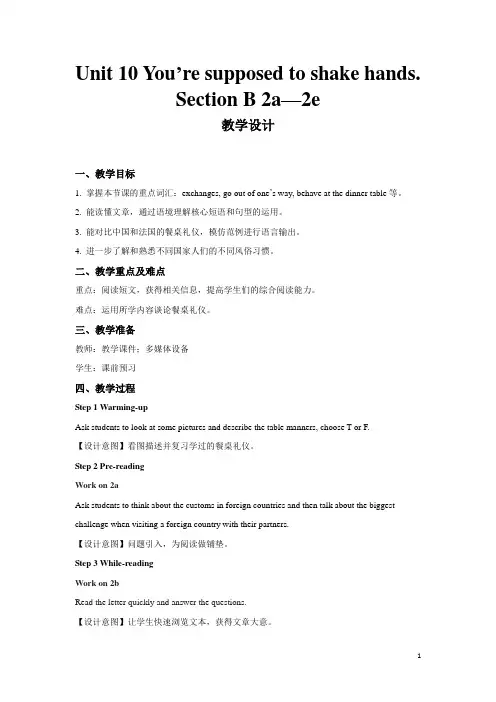
Unit 10 You’re supposed to shake hands.Section B 2a—2e教学设计一、教学目标1. 掌握本节课的重点词汇:exchanges, go out of one’s way, behave at the dinner table等。
2. 能读懂文章,通过语境理解核心短语和句型的运用。
3. 能对比中国和法国的餐桌礼仪,模仿范例进行语言输出。
4. 进一步了解和熟悉不同国家人们的不同风俗习惯。
二、教学重点及难点重点:阅读短文,获得相关信息,提高学生们的综合阅读能力。
难点:运用所学内容谈论餐桌礼仪。
三、教学准备教师:教学课件;多媒体设备学生:课前预习四、教学过程Step 1 Warming-upAsk students to look at some pictures and describe the table manners, choose T or F.【设计意图】看图描述并复习学过的餐桌礼仪。
Step 2 Pre-readingWork on 2aAsk students to think about the customs in foreign countries and then talk about the biggest challenge when visiting a foreign country with their partners.【设计意图】问题引入,为阅读做铺垫。
Step 3 While-readingWork on 2bRead the letter quickly and answer the questions.【设计意图】让学生快速浏览文本,获得文章大意。
Work on 2cReplace the underlined words with the phrases.Work on 2dRead the letter carefully and make notes about French customs in the chart.【设计意图】让学生带着问题去阅读,从而准确获得信息。
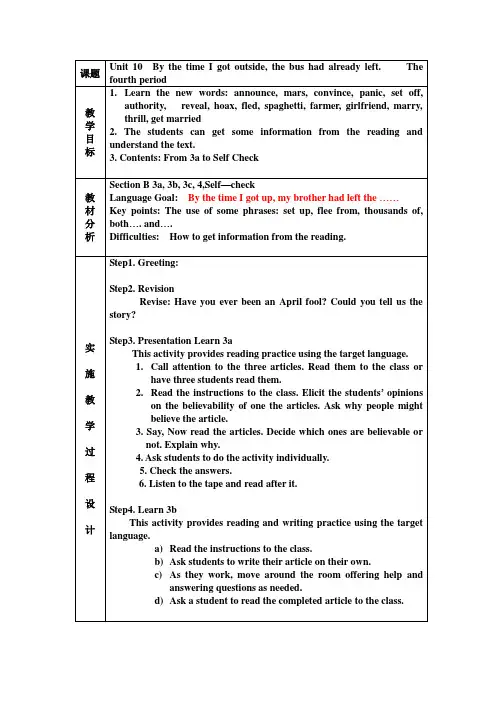
课题Unit 10 By the time I got outside, the bus had already left. The fourth period教学目标1.Learn the new words: announce, mars, convince, panic, set off,authority, reveal, hoax, fled, spaghetti, farmer, girlfriend, marry, thrill, get married2. The students can get some information from the reading and understand the text.3. Contents: From 3a to Self Check教材分析Section B 3a, 3b, 3c, 4,Self—checkLanguage Goal:By the time I got up, my brother had left the ……Key points: The use of some phrases: set up, flee from, thousands of, both…. and….Difficulties: How to get information from the reading.实施教学过程设计Step1. Greeting:Step2. RevisionRevise: Have you ever been an April fool? Could you tell us the story?Step3. Presentation Learn 3aThis activity provides reading practice using the target language.1.Call attention to the three articles. Read them to the class orhave three students read them.2.Read the instructions to the class. Elicit the students’ opinionson the believability of one the articles. Ask why people mightbelieve the article.3. Say, Now read the articles. Decide which ones are believable ornot. Explain why.4. Ask students to do the activity individually.5. Check the answers.6. Listen to the tape and read after it.Step4. Learn 3bThis activity provides reading and writing practice using the target language.a)Read the instructions to the class.b)Ask students to write their article on their own.c)As they work, move around the room offering help andanswering questions as needed.d)Ask a student to read the completed article to the class.实施教学过程设计Step5. Learn 3cThis activity provides reading and writing practice using the target language.1. Read the instructions to the class.2. Ask students to make a list of ideas before they start writing.3. Tell students they can use the article they wrote for activity3a as a model.4. Correct as many as of the articles as you can in class. Asksome students to read their articles to the class.Step6 Learn 4This activity provides reading, speaking and listening practice using the target language.1.Read the conversation in the box.2.Ask students to read their stories to the class. After all ofthe students have read, ask the class to vote for thefunniest, most embarrassing, and most creative stories. Step7. Self—Check1 This activity focuses on vocabulary introduced in the unit.a.First ask students to find out the meanings of each word.b.Then ask them to fill in the blanks with these words.c.Check the answers.d.Ask students to make their own sentences with the words,2. This activity provides writing practice using the target language.1. Point to the pictures and ask students what is happening.2. Read the instructions to the class.3. Point out the picture and ask students to talk about what they see.4. Ask students to write a story about Ming’s day on their own.3. This activity focuses on the new vocabulary introduced in the unit.Ask students to circle the words that don’t belong in each line. Step8. Homework:a)Write about a joke you played on someone or a jokesomeone played on you. Tell what happened in it.教学反思。
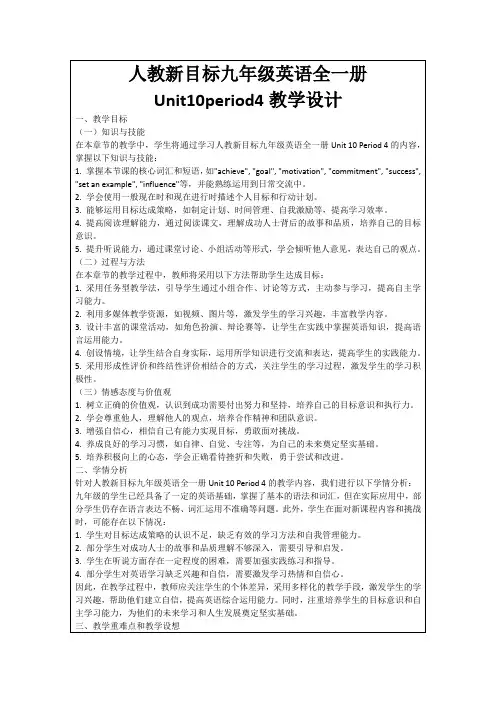
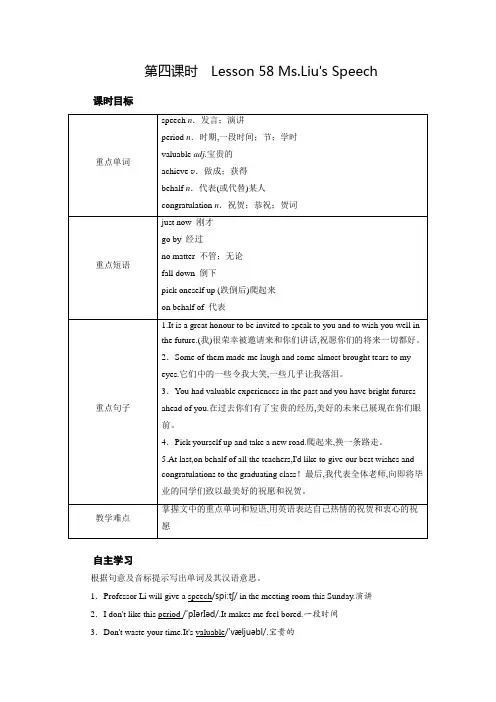
第四课时Lesson 58 Ms.Liu's Speech 课时目标自主学习根据句意及音标提示写出单词及其汉语意思。
1.Professor Li will give a speech/spiːtʃ/ in the meeting room this Sunday.演讲2.I don't like this period /'pIərIəd/.It makes me feel bored.一段时间3.Don't waste your time.It's valuable/'væljuəbl/.宝贵的4.She achieved /ə'tʃiːvd/ nothing after so many years' hard work.做成5.My mother attended this meeting yesterday on behalf/bI'hɑːf/ of our family.代表教学过程环节1新课导入教师通过PPT展示与演讲和毕业典礼有关的图片,然后提出下列问题:T:Can you list something memorable during the three years?S1:Of course! On a rainy day,I forgot to take my umbrella,so I got wet...But my classmates...T:What will you say if you are asked to give a speech in front of your teachers and classmates?S2:Maybe I will say good luck to all of my...and I will...T:So many ideas you have! Today we are going to learn Ms.Liu's speech for the graduates.设计意图:通过展示图片和提问问题的形式呈现本课时的主题,直观形象,能更好地调动起学生的积极性,活跃课堂氛围。
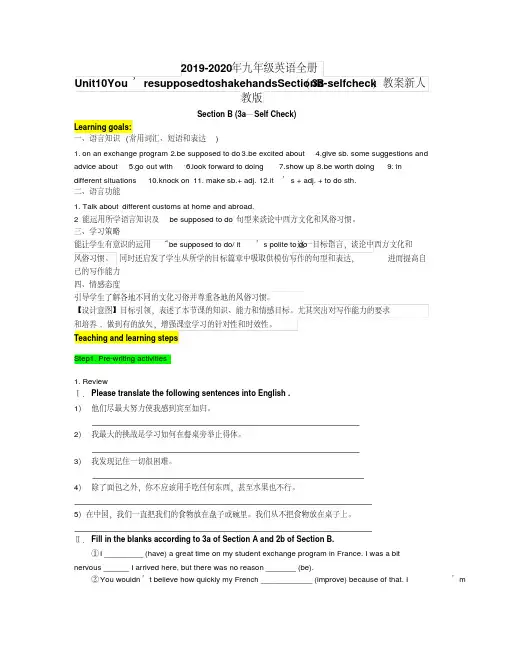
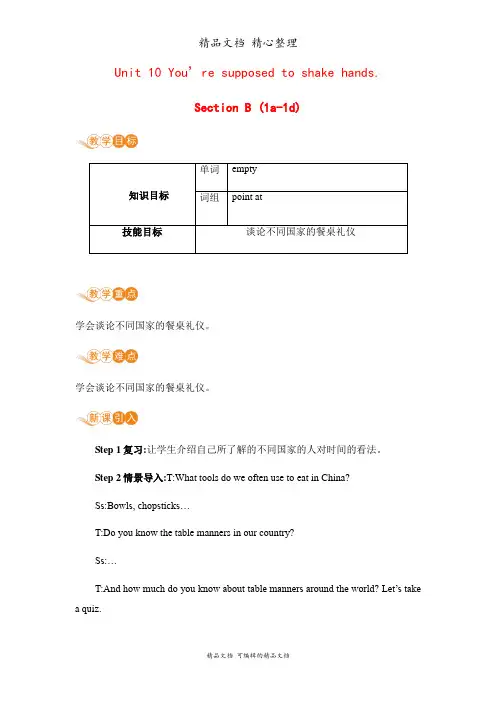
Unit 10 You’re supposed to shake hands.Section B (1a-1d)单词empty学会谈论不同国家的餐桌礼仪。
学会谈论不同国家的餐桌礼仪。
Step 1复习:让学生介绍自己所了解的不同国家的人对时间的看法。
Step 2情景导入:T:What tools do we often use to eat in China?Ss:Bowls, chopsticks…T:Do you know the table manners in our country?Ss:…T:And how much do you know about table manners around the world? Let’s take a quiz.Step 3完成教材1a-1d中的任务:1.你对世界各国的餐桌礼仪了解多少?完成1a中的问题,圈出每一种说法的正误。
2.认真听录音,将杨明告诉史蒂夫有关中国的餐桌礼仪按照你所听到的顺序给图片排序。
3.再认真听一遍录音,将1c中的句子相匹配。
4.仿照1d的对话格式,与小组成员讨论你们国家的其他餐桌礼仪。
Step 4小结训练根据汉语意思完成句子1.在美国,你不应该用手拿东西吃。
In the United States, you’re with your hands.2.把筷子插在食物里是不礼貌的。
stick your chopsticks into your food.3.如果餐桌上有老人在场,你不应该先吃。
You’re start eating first if there are older people at the table.4.你不应该用筷子指着任何人。
You point anyone your chopsticks.答案:1.not supposed to eat2.It’s impolite to3.not supposed to4.shouldn’t; at; with1.She was supposed in hospital, but people found her in the office.A.to lieB.lyingC.lieD.lies答案:Abe supposed to do sth. 意为“应该做某事;被期望做某事”。
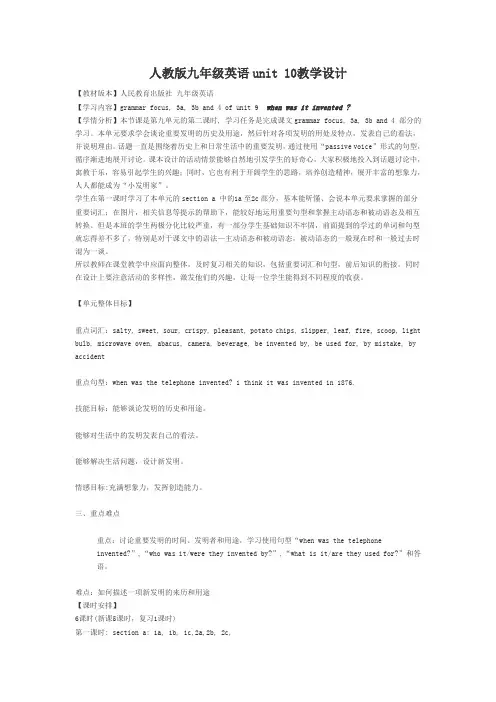
人教版九年级英语unit 10教学设计【教材版本】人民教育出版社九年级英语【学习内容】grammar focus, 3a, 3b and 4 of unit 9 when was it invented ?【学情分析】本节课是第九单元的第二课时, 学习任务是完成课文grammar focus, 3a, 3b and 4 部分的学习。
本单元要求学会谈论重要发明的历史及用途,然后针对各项发明的用处及特点,发表自己的看法,并说明理由。
话题一直是围绕着历史上和日常生活中的重要发明,通过使用“passive voice”形式的句型,循序渐进地展开讨论。
课本设计的活动情景能够自然地引发学生的好奇心,大家积极地投入到话题讨论中,寓教于乐,容易引起学生的兴趣;同时,它也有利于开阔学生的思路,培养创造精神,展开丰富的想象力,人人都能成为“小发明家”。
学生在第一课时学习了本单元的section a 中的1a至2c部分,基本能听懂、会说本单元要求掌握的部分重要词汇;在图片,相关信息等提示的帮助下,能较好地运用重要句型和掌握主动语态和被动语态及相互转换。
但是本班的学生两极分化比较严重,有一部分学生基础知识不牢固,前面提到的学过的单词和句型就忘得差不多了,特别是对于课文中的语法—主动语态和被动语态,被动语态的一般现在时和一般过去时混为一谈。
所以教师在课堂教学中应面向整体,及时复习相关的知识,包括重要词汇和句型,前后知识的衔接。
同时在设计上要注意活动的多样性,激发他们的兴趣,让每一位学生能得到不同程度的收获。
【单元整体目标】重点词汇:salty, sweet, sour, crispy, pleasant, potato chips, slipper, leaf, fire, scoop, light bulb, microwave oven, abacus, camera, beverage, be invented by, be used for, by mistake, by accident重点句型:when was the telephone invented? i think it was invented in 1876.技能目标:能够谈论发明的历史和用途。
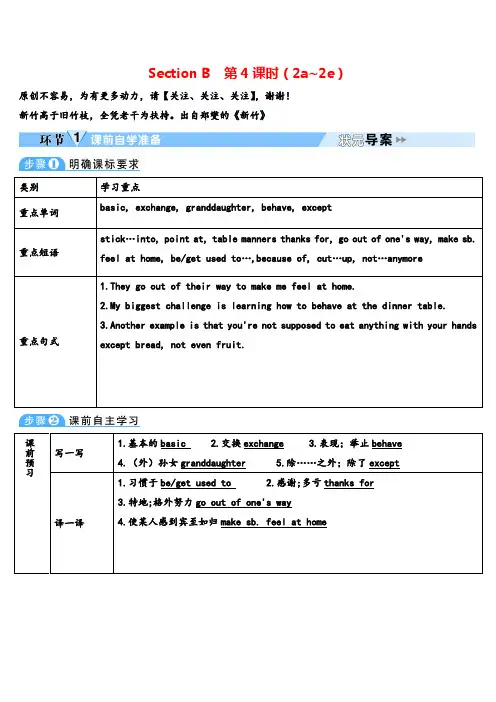
Section B 第4课时(2a~2e)原创不容易,为有更多动力,请【关注、关注、关注】,谢谢!新竹高于旧竹枝,全凭老干为扶持。
出自郑燮的《新竹》类别学习重点重点单词basic, exchange, granddaughter, behave, except重点短语stick…into, point at, table manners thanks for, go out of one's way, make sb.feel at home, be/get used to…,because of, cut…up, not…anymore重点句式1.They go out of their way to make me feel at home.2.My biggest challenge is learning how to behave at the dinner table.3.Another example is that you're not supposed to eat anything with your handsexcept bread, not even fruit.课前预习写一写1.基本的basic2.交换exchange3.表现;举止behave4.(外)孙女granddaughter5.除……之外;除了except译一译1.习惯于be/get used to2.感谢;多亏thanks for3.特地;格外努力go out of one's way4.使某人感到宾至如归make sb. feel at home背一背1.他们努力让我感到宾至如归。
They go out of their way to make me feel at home.2.我最大的挑战是学习如何在餐桌上举止得体。
My biggest challenge is learning how to behave at the dinner table.新课导入Teacher: If you are an exchange student in France, wil you be nervous? Do you know how to behave at the dinner table? Are you used to using forks and knives? What should you do if you don\'t know how to use them? Do you know how Lin Yue deals with the questions? Read the passage in 2b,you will know eveything.新课展示【完成教材2a~2e的教学任务】1.快速浏览一遍2a的内容。
Period4 Section B (1a-2e)【知识与能力目标】1) 能掌握以下单词:empty basic, exchange, go out of one’s way, make …feel at home, teenage, granddaughter, behave, except, elbow, gradually, get used to2) 能掌握以下重难点句子:You’re supposed to …You’re not supposed to…It’s impolite to …You shouldn’t …3) 提高学生的听力水平。
4)培养学生的阅读能力,理解关键词和短语的能力。
【过程与方法目标】本课主要采用任务型教学法,情景教学法以及多媒体辅助教学,充分发挥教师的主导作用和学生的主体地位。
利用现代化教育技术优化教学过程,通过课件为学生创设更多生动活泼的语言环境,把学生吸引到活动中去,并激发他们主动参与学习的欲望,努力培养学生自主学习的能力。
把学习的钥匙交给学生,在传授知识的同时,授以科学的思维方法。
不仅要使学生学会,更要使学生会学。
【情感态度价值观目标】1)通过对一些国家的风俗习惯和饮食文化。
餐桌礼仪的了解,进一步提高学生对文明生活的认识。
2)通过学习了解各国的基本礼仪。
3)培养学生良好的合作能力和良好的行为习惯。
【教学重点】1) 掌握本课时出现的生词及用法。
2) 进行听力训练,提高综合听说能力。
3)阅读短文,获得相关信息,提高学生们的综合阅读能力。
【教学难点】1. 运用所学内容谈论餐桌礼仪。
2. 在听的过程中获取有用的信息。
【教学步骤】Step 1. Warm- up and revision1. Daily greetings.2. Check the homework.3. 让学生展示“哥伦比亚和瑞士的礼仪”的短文。
对于好的给予鼓励。
Step 2. Lead in利用大屏幕展示一些国家吃饭的情景,或一些在餐馆吃饭的图片,边放边介绍,让学生对中西方就餐文化有所了解,并引入新课。
第4课时Section B (2a-3b)【教学目标】1.要求学生能读懂有关不同国家的饮食、生活习俗的文章。
2.培养学生尊重不同的文化,进一步提高对文明生活的认识。
3.学会注意文章的细节。
【教学重难点】重点:掌握单词basic,exchange,granddaughter,behave,except等。
难点:会熟练运用be supposed to的用法。
【自主学习案】1.预习课本P78-79新单词并背诵,完成下面的汉译英。
(1)基本的;基础的basic(2)交换exchange(3)(外)孙女granddaughter (4)表现;举止behave(5)逐步地gradually (6)除……之外except2.认真预习课本P78-79的内容,找出下列短语和句型。
(1)特地;格外努力go__out__of__one's__way(2)使(某人)感到宾至如归make…feel__at__home(3)习惯于get__used__to(4)在我到达这儿之前,我有点紧张,但其实没有理由这样。
I was a bit nervous before I arrived here, but there was no reason to be.(5)她总是用法语和我交谈来帮助我练习法语。
She always talks to me in French to help me practice.(6)我不得不要说我发现记住一切是困难的,但是我逐渐习惯了。
I have to say that I find it difficult to remember everything,but I am gradually getting used_to__it.【课堂导学案】Step 1复习(1分钟)让学生介绍中国的餐桌礼仪。
Step 2情景导入(2分钟)T:If you are an exchange student in France,are you nervous?Do you know how to behave at the dinner table?Are you used to using forks and knives?What should you do if you don’t know how to use them?Do you know how Lin Yue deals with the questions?Read 2b,you will know everything.环节说明:通过一系列问题让学生有一种好奇心去阅读短文,从而使大脑更活跃,效果更佳。
第四课时Section B (2a-2e) 课时目标自主学习一、根据句意及汉语提示写出单词。
1.My daughter's daughter is my granddaughter(外孙女).2.You should behave(表现) properly when you have an interview.3.Everyone is here except (除了)John.He is ill in hospital.4.The plots of the story gradually(逐渐地) developed in my mind.5.Peter is an exchange (交换)student from America.二、写出下列画线短语的汉语意思。
1.I was a_bit nervous before I arrived here,but there was no reason to be.有点儿;稍微2.You wouldn't believe how quickly my French has improved because_of that.由于3.Although I still make_lots_of_mistakes,it doesn't worry me as it used_to.犯许多错;过去常常4.As you can imagine,things are very different_from the way they are at home.和……不同5.I thought that was pretty strange at_first,but now I'm_used_to it.最初;习惯教学过程环节1新课导入老师以多媒体的形式展示几张有关法国的图片,然后老师以提问的方式询问学生有关法国的信息。
T:Boys and girls,do you know anything about France?S1:I know its capital is Paris.It is a city of fashion.S2:Its flag is red,blue and white.S3:It is famous for its Eiffel Tower,red wine and bread....设计意图:以图片的形式吸引学生的眼球,丰富教学内容,改变传统的教学方式,让学生更易接受。
Unit 10 By the time I got outside,the bus had already left.第四课时Section B (1a-2c) 听说课Learning Goals:Go on learning the Past Perfect Tense. Learn the key words by heart:costume, show up, exhausted, embarrassed, empty, fool, April Fool’s Day, go off, stay up, invite, get up, get dressed,realize, change. Learn about April Fool’s Day .Step1: Preview1. Ask students to read the words or phrases one by one. Then put these words in the correct columns in the chart.(noun , verb, adjective) .Finally ask them to use key words to make sentences. You may ask several students to write them down on the blackboard .( 以小组形式交流学习各部分内容,交流解决预习中的问题。
)2. Translate the phrases into English .1、穿衣服____________2、出现、露面______________3、感到精疲力竭的_________4、邀请某人做事___________5.化妆舞会___________ 6、感到尴尬______________7、举行数学考试__________ 8、熬夜____________9、发出响________ 10、大卫愚人节的时候怎么了?______________ (设计意图:通过以上单词短语及句子的练习,让学生能够抓住重点,有针对性的去学,也为下一步分层次布置作业打下基础。
课题
课
型
New
Lesson
第 4
课时教学过程
二
次
备
课
Ⅰ. Warming- up and revision
1. D aily greeting.
2. Check the homework.
3. 让学生展示“哥伦比亚和瑞士的礼仪”的短文。
对于好的给予鼓励。
Ⅱ. Lead in
利用大屏幕展示一些国家吃饭的情景,或一些在餐馆吃饭的图片,边放边介绍,让学生对中西方就餐文化有所了解,并引入新课。
Ⅲ. Presentation
1. Work on 1a. How much do you know about table manners around the world? Take the following quiz. Circle T for true or F for false after each sentence.
Mind your manners!
1. In India, you’re supposed to eat with your
hands. T F
2. In China, you’re not supposed to stick your chopsticks into the food. T F
3. In Korea, the youngest person i s expected to start eating first. T F
4. In France, you’re supposed to put your bread on the table. T F
5. In China, it’s impolite to use your chopsticks to hit an empty bowl. T F
1)先让学生自己做,老师指导,让他们理解每个句子的意思。
2)共同讨论,核对答案。
2. Listening. Work on 1b. Steve is going to China to study. His friend Yang Ming is telling him about the table manners in China. Listen and number the pictures in the order you hear them. Work on 1c. Listen again. Match the sentence parts.
____ 1. You’re not supposed to…
____ 2. It’s impolite to…
____ 3. You shouldn’t… a. stick your chopsticks into your food.。